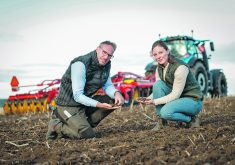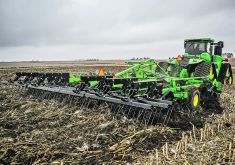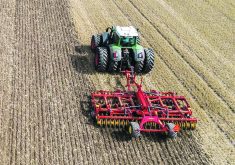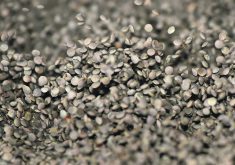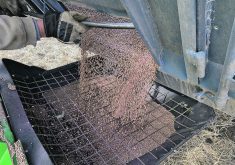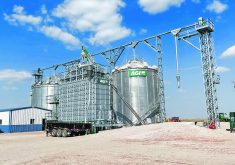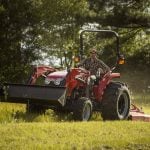Broad-acre, seed-singulating seed unit combines the productivity of an air drill and the accuracy of a planter
Growers have been vexed by a difficult choice for decades. The tradeoff between the productivity of an air drill and the accuracy of a planter.
For broad-acre growers in Western Canada, a large one-pass system capable of applying a massive amount of fertilizer and seed between fills seems an obvious choice.
But the in-the-row spacing, picket-fence perfect crop stand, and seed savings that planters offer, have many growers hitched to large drills envious.
The Prince family from the near Pipestone, Man., found a way out of this trade-off by developing their own planters geared for broad-acre production.
Read Also

Farming Smarter receives financial boost from Alberta government for potato research
Farming Smarter near Lethbridge got a boost to its research equipment, thanks to the Alberta government’s increase in funding for research associations.
The family has grown corn and soybeans for more than a decade and learned the hard way that no planter on the market comes set up to work the way they need it.
Because of all the upgrade their planters needed before they would work for the family, they started a precision planter dealer called Capricorn Bay.
Over the years, the company added additional product lines to optimize the row units’ productivity in the growing area.
Finally, the Prince family decided the only way to get their hands on a planting implement that covers all the bases they want is to build it themselves.
“People had to do a lot of upgrades to their planter to make it work for where we are. We found it was easier to build it from scratch than it was to fix up something that was already out there,” said Frank Prince of Capricorn Bay.
The company brought to market a single- and a double-rank toolbar that’s built for the row units it sells, including from Agco, Harvest, and John Deere.
“We can get down to 10-inch spacing so we can really seed any crop out there with precision accuracy,” Prince said.
At Canada’s Farm Progress Show in Regina the company displayed a 60-foot-wide single toolbar that sits on tracks and has recently been fitted with a commodity and liquid tank on the planter’s main frame.
Prince said most planters come with about 100 bushels of on-frame storage of seed, which is usually enough for corn or canola.
“You can get 200 acres of corn in, no problem, and canola you can go for days. But when it comes to soybeans that works out to be about an 80-acre fill. But in Western Canada, a lot of our fields are much, much bigger than that,” Prince said.
So Capricorn Bay repurposed a 280-bu. tank off a Versatile air cart that was sitting in the Prince yard, installed John Deere meters on it, and then placed it on their planter.
“We are doing 200-acre fills in soybeans. I know it wasn’t super dry this spring, but every wet spot there was that we haven’t seed for years we were going through and had enough flotation and everything worked fine. We also have 1,000 gallons of liquid on the front, which matches up with that 200 acres,” Prince said.
If growers want to apply more fertilizer, he said they can pull a caddy behind.
The big draw back with a single toolbar is there isn’t a place to put fertilizer coulters on it.
“With this planter specifically we do in-furrow fertilizer, liquid through the Keeton. Or if you are looking to do dry, we can put a dry tube down and put dry in-furrow,” Prince said.
“There is also an ag focus closing systems where there is a place to put liquid on that would give it two inches over but not super deep.”
He said the single toolbar on 15-inch spacing is being used by growers to seed canola, corn, soybean and hemp.
The double-rank toolbar Capricorn Bay builds has been used to plant wheat, barley, oats, chickpeas, and lentils.
“There hasn’t been anything that I have found that won’t meter through our meters.”
The double-rank 60-foot planter, dubbed the hybrid planter, also has a row for fertilizer coulters so operators can mid-row band or place fertilizer in a two-by-two pattern.
This planter’s on-board product capacity is limited by the commodity cart size operators choose to pair with it.
Prince said he used skinny style John Deere row units to reduce congestion on the toolbar.
“It’s setup on 10-inch spacing with mid-row fertilizer on it, but operators can still get in to access the row units,” he said.
“Guys that have been using the single toolbar are switching to the double because they say there is better residue movement between the rows and it’s easier to work on,” Prince said.
“I can now pull a caddy behind me and put on all my fertilizers in one pass and also carry even more seed for these big fields.”
There are numerous options growers can enhance their row units with, including individual-row, variable-rate, turn-rate compensation. Other options include trash wheels, speed tubes, gauge wheels, hydraulic down force that reacts five times per second, and seed firmers, such as the Smart Firmer by Precision Planting that measures soil moisture, temperature, organic matter and how much light is in the row.
“This is the first year you could get your hands on them (Smart Firmer). We ran them with two or three per planter. We found it very helpful to know your depth is set correct. Because as you’re going across the field, you could see the moisture content of your soil. We set it to where we would normally seed and then we could see that our soil moisture wasn’t high enough in some areas,” Prince said.
The cost for Capricorn Bay’s planters depends on the number of rows units included.
“For example on a 60-foot on 15 inches, it has the same number of rows as a 40-foot on 10 inches, and it works out to be about $450,000 to $500,00 for 47 rows,” Prince said.
“And then you can equip that however you want. If you add speed tubes, well they’re $1,000 a row. It doesn’t take long to add price, but that would be what most guys are looking for in Western Canada would be in that price range.”






